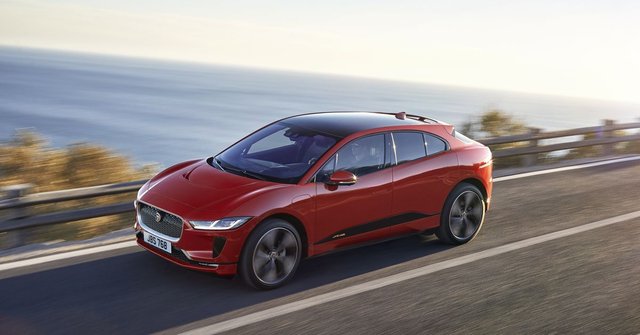After two years of teasing the concept version of its first all-electric car, British automaker Jaguar has finally revealed the production model of the I-Pace SUV. It’s a sharply-styled, five-seater crossover that is aimed squarely at the high end of the car market that Jaguar typically operates in, where it will instantly slot in as the most direct competition to Tesla’s Model X electric SUV when it goes on sale later this year. Pricing is expected to be announced next week when Jaguar shows the new car off at the Geneva Motor Show.
The production model basically matches the specs Jaguar originally set out to achieve with the I-Pace concept. A 90 kWh battery will give it an estimated 240 miles of range, which is more than enough for day-to-day driving. If and when you wind up running low on charge, Jaguar says the batteries can go from zero to 80 percent in just 40 minutes at 100kW DC fast charging stations. (A similar charge on a Level 2 home charger will take about 10 hours, according to Jaguar.)
With regards to performance, the dual motors — one on each axle — combine to give the I-Pace 394 horsepower, which gets it from 0–60 miles per hour in 4.5 seconds, Jaguar says. The company is promising a smooth ride, too, as active air suspension comes standard. Jaguar’s driver assistance features will be included as well.
These specs line up favorably with the entry-level Model X 75D, which goes from 0–60 in 4.9 seconds and has a range of 237 miles. Tesla’s higher-spec Model X 100D, which has a larger battery pack, can reach almost 300 miles though, and the “performance” version (the P100D) is twice as quick to 60 miles per hour.
The competition in the all-electric segment of the market is only going to heat up once the I-Pace hits the market, though. The long-range version of the recently announced Hyundai Kona Electric, for example, also scratches that 300-mile benchmark. That’s not to say prospective I-Pace buyers would also consider something like the more affordable Kona. But it’s worth noting that both Hyundai and Tesla were able to squeeze better range out of battery packs with less capacity — the Kona Electric long-range model uses a 64kWh pack, and the Model X 75D’s is 75kWh.
The I-Pace will be the first Jaguar to get over-the-air updates
Jaguar is looking to distinguish the I-Pace with fresh design and technology inside the car as well. The electric SUV uses the same radical dual-screen InControl Touch Pro Duo infotainment system that Jaguar launched on the Range Rover Velar. Additionally, the InControl Remote app is getting an Alexa skill that will let drivers ask Alexa-enabled devices for information on the I-Pace’s charge level.
Additionally, the I-Pace will be the first Jaguar to get over-the-air software updates. It also has slots for tablets and laptops under the rear seats, six USB ports, and three 12V sockets, and it comes with a 4G Wi-Fi hotspot.
With all that in mind, the I-Pace isn’t going to be everything for everyone. It matches the base level Model X on performance specs, though it obviously doesn’t have Autopilot, and it won’t travel as far per charge as the higher-end Teslas (or even a higher-end Hyundai). It has a fairly futuristic infotainment system with an Alexa tie-in, but it’s not a full version of Amazon’s voice assistant. There’s plenty of storage, thanks to the extra space that comes with the lack of an internal combustion engine and its subsequent parts, but it’s not as roomy as the seven-seater Model X.
Still, Jaguar’s I-Pace looks like a thrilling entry in the top end of the budding EV market. It’s sleek, it’s fast, and it sounds more than capable of replacing any modern SUV in most everyday settings. It’s frankly an exciting start of a new chapter from one of the world’s preeminent luxury automakers.
Hi! I am a robot. I just upvoted you! I found similar content that readers might be interested in:
http://brightstarnews.com/jaguars-i-pace-is-a-speedy-dual-motor-model-x-competitor/
Downvoting a post can decrease pending rewards and make it less visible. Common reasons:
Submit